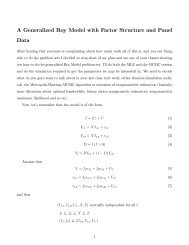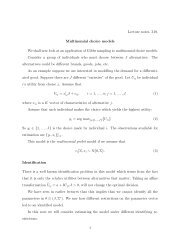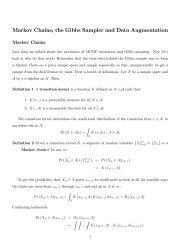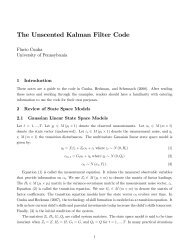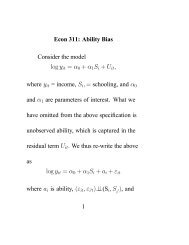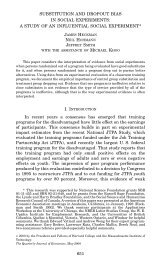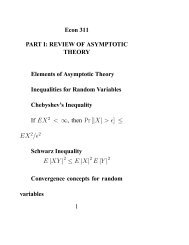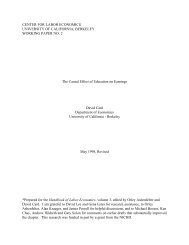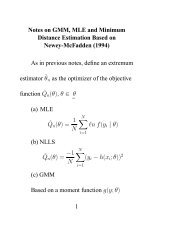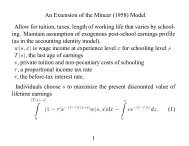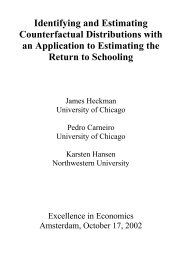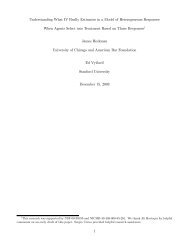OECD (2000)
OECD (2000)
OECD (2000)
You also want an ePaper? Increase the reach of your titles
YUMPU automatically turns print PDFs into web optimized ePapers that Google loves.
© <strong>OECD</strong> <strong>2000</strong><br />
328<br />
Table 1.<br />
0. PRE-PRIMARY LEVEL OF EDUCATION Main criteria Auxiliary criteria<br />
Description of ISCED-97 levels, classification criteria, and sub-categories<br />
Initial stage of organised instruction, designed Should be centre or school-based, be designed Pedagogical qualifications for the teaching<br />
primarily to introduce very young children to a to meet the educational and developmental staff; implementation of a curriculum w ith<br />
school-type environment. needs of children at least 3 years of age, educational elements.<br />
and have staff that are adequately trained<br />
(i.e ., qualified) to provide an educational<br />
programme for the children.<br />
ANNEX 3<br />
1. PRIMARY LEVEL OF EDUCATION Main criteria Auxiliary criteria<br />
Normally designed to give students a sound Beginning of systematic studies characteristic In countries where the age of compulsor y<br />
basic education in reading, writing of primary education, e.g . reading, writing attendance (or at least the age at which<br />
and mathematics. and mathematics. Entry into the nationally virtually all students begin their education)<br />
designated primary institutions<br />
or programmes.<br />
The commencement of reading activities alone<br />
is not a sufficient criteria for classification<br />
of an educational programmes at ISCED 1.<br />
comes after the beginning of systematic study<br />
in the subjects noted, the first year<br />
of compulsory attendance should be used<br />
to determine the boundary between ISCED 0<br />
and ISCED 1.<br />
Destination for which<br />
2. LOWER SECONDARY LEVEL OF EDUCATION Main criteria Auxiliary criteria the programmes have been Programme orientation<br />
designed to prepare students<br />
The lower secondary level of education Programmes at the start of level 2 should If there is no clear break-point for this A. Programmes designed 1. Education which is not designed explicitly<br />
generally continues the basic programmes correspond to the point where programmes organisational change, however, then countries t o prepare students for direct to prepare participants for a specific class of<br />
of the primary level, although teaching are beginning to be organised in a more should artificially split national programmes acces s to level 3 in a sequence occupations or trades or for entry into further<br />
is typically more subject-focused, often subject-oriented pattern, using more into ISCED 1 and 2 at the end of 6 years which would ultimately lead vocational/technical education programmes.<br />
employing more specialised teachers who specialised teachers conducting classes of primary education. to tertiary education, that is, Less than 25 per cent of the programme<br />
conduct classes in their field of specialisation. in their field of specialisation. entrance to ISCED 3A or 3B. content is vocationa l or technical.<br />
If this organisational transition point does not In countries with no system break between B. Programmes designed 2. Education mainly designed as an introduction<br />
correspond to a natural split in the boundaries lower secondary and upper secondary to prepare students for direct to the world of work and as preparation<br />
between national educational programmes, education, and where lower secondary access to programmes for further vocational or techn ical education.<br />
then programmes should be split at the point education lasts for more than 3 years, only at level 3C. Does not lead to a labour-ma rket relevant<br />
where national programmes begin to reflect the first 3 years following primary education qualification. Content is at least 25%<br />
this organisational change. should be counted as lower secondary vocational or technical.<br />
education.<br />
C. Programmes primarily designed 3. Education which prepares participants<br />
for direct access to the labour for direct entry, without further training, into<br />
market at the end of this<br />
specific occupations. Successful completion<br />
level (sometimes referred to as of such programmes leads to a labour-market<br />
‘‘terminal’’ programmes).<br />
relevant vocational qualification.<br />
Destination for which<br />
3. UPPER SECONDARY LEVEL OF EDUCATION Main criteria Modular programmes the programmes have been Programme orientation<br />
designed to prepare students<br />
The final stage of secondary education in most National boundaries between lower secondary An educational qualification is earned i n a A. ISCED 3A: programmes 1. Education which is not designed explicitly<br />
<strong>OECD</strong> countries. Instruction is often more and upper secondary education should be modular programme by combing blocks at level 3 d esigned to provide to prepare participants for a specific class of<br />
organised along subject-matter lines than the dominant factor for splitting levels 2 of courses, or modules, into a programme dire ct access to ISCED 5A. occupations or trades or for entry into further<br />
at ISCED level 2 and teachers typically need and 3. meeting specific curricular requirements. vocational/technical education progra mmes.<br />
to have a higher level, or more<br />
subject-specific, qualification that at ISCED 2.<br />
Less than 25 per cent of the programme<br />
content is vocational or technical.<br />
Admission into educational programmes A single module, however, may not have B. ISCED 3B: programmes 2. Education mainly designed as an introduction<br />
usually require the completion of ISCED 2 a specific educational or labour market at level 3 designed to provide to the world of wo rk and as preparation<br />
for admission, or a combination of basic destination or a particular programme direct access to ISCED 5B. for further vocational o r technical education.<br />
education and life experience that demonstrates orientation. Does not lead to a labour-market relevant<br />
the ability to handle ISCED 3 subject matter. qualification. Content is at least 25%<br />
vocational or technical.<br />
There are substantial differences in the typical Modular programmes should be classified C. ISCED 3C: programmes 3. Education which prepares participants<br />
duration of ISCED 3 programmes both across at level ‘‘3’’ only, without reference to the at level 3 not designed to lead for direc t entry, without further training, into<br />
and between countries, typically ranging from educational or labour market destination directly to ISCED 5A or 5B. specific occupat ions. Successful completion<br />
2 to 5 years of schooling. of the programme. Therefore, these programmes of such programmes leads to a labour-market<br />
lead directly to labour market, relevant vocational qualification.<br />
ISCED 4 programmes or other<br />
ISCED 3 programmes.



